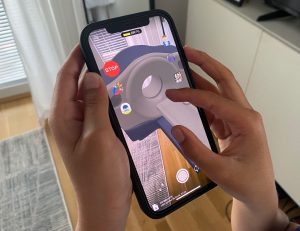Prototypical Development of an Augmented Reality Tool for Demonstrating a Fictive Magnetic Resonance Imaging Procedure to Children and Parents and Evaluation of its Usability and Perceived Impact on Education and Anxiety Reduction
Aim and Research Question(s)
This thesis aimed to develop and evaluate an Augmented reality (AR) tool, focusing on these questions: 1. What are the perceptions of children and their parents regarding the usability of a prototypical AR experience designed to educate them about a fictive MRI procedure? 2. How do they evaluate the impact of the AR experience on improving their understanding of an fictive MRI procedure, and to what extent does this contribute to anxiety reduction, as perceived by parents?
Background
MRI exams can be intimidating for children due to the confined tube, loud noises, and the need to remain still, making patient education essential, which can help demystify the process. Providing advanced preparation tools can improve understanding, reducing anxiety [1]. AR technology, with its immersive simulations, has great potential to improve patient education and elevate learning experience [2].
Methods
A prototypical AR tool illustrating MRI procedures was developed using Meta Spark Studio and tested by five children aged 7-9 and their parents, who interacted with the tool on an iPhone exploring each scene. The evaluation involved post-testing questionnaires completed by both groups (FUN Toolkit for children, SUS and uMARS for parents).

Results and Discussion
Children's Results
- High usability indicated by enjoyment and satisfaction measured through Fun Toolkit: 4/5 expressed strong liking; 1 liked it; no negative responses; 4/5 would use it again; all would recommend it
- Understood MRI processes, perceived no need to fear MRI
- No usability problems observed during testing
Parent's Results
- Average SUS score 83
- uMARS feedback: App Quality Mean Score 4.1, Subject Quality Mean Score 4.2, Perceived Impact Mean Score 4.3
- Praised the tool's potential to enhance understanding and reduce MRI-related fears
- Suggested improvements: more detailed information about procedures and processes
Conclusion
This study shows the tool’s high usability and the positive impact of AR in educating about MRI procedures, aligning with previous research emphasizing its potential to enhance patient experience. Further prototype development and future studies on effectiveness before children's real MRI exams could be aimed at.
References
[1] O. Lawal, P. Regelous, and D. Omiyi, ‘Supporting claustrophobic patients during Magnetic resonance imaging examination– the patient perspective’, Radiography, vol. 29, no. 6, pp. 1108–1114, Oct. 2023, doi: 10.1016/j.radi.2023.09.008. [2] A. Jakl et al., ‘Enlightening Patients with Augmented Reality’, in 2020 IEEE Conf. on VR and 3D UIs (VR), Mar. 2020, pp. 195–203. doi: 10.1109/VR46266.2020.00038.
